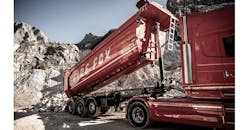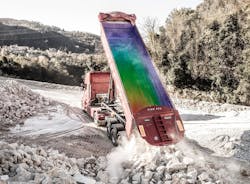Mantella, a family-owned business in Southern Italy, recently redesigned its Stratosphere tipper trailer with the latest high-tech materials developed by Nordic steel manufacturer SSAB.
The company says the use of SSAB’s Hardox 500 Tuf and Strenx 960 high-strength steel revolutionizes it tipper, increasing payload, fuel efficiency and durability.
The combined weight reduction of using abrasion-resistant Hardox 500 Tuf in the body and Strenx 960 in the chassis is 1,124 pounds, compared to the previous design, Mantella said, which translates to an increased payload of more than 1,000 pounds every trip, nd higher load capacity is what most customers want.
The new design won the international Swedish Steel Prize 2018.
Mantella says reducing weight also improves sustainability by saving fuel and reducing CO2 emissions, which is important since road transport accounts for 17.5% of overall gas emissions in Europe, according to the European Environment Agency.
“By lowering fuel consumption and CO2 emissions per ton kilometer, we are contributing to a more sustainable world,” said Gregorio Mantella, plant director at Mantella Srl. “To successfully develop this lightweight trailer, the entire company has been involved—design engineers, production, management and purchasers.
“The Stratosphere trailers make use of all the benefits obtainable from SSAB’s high-strength steel grades Hardox 500 Tuf and Strenx 960. Naturally we are also in the process of implementing stronger and lighter design solutions for our other trailer series.”
With the high wear resistance of Hardox 500 Tuf wear plate, Mantella was able to reduce plate thickness by 1 millimeter (.039 inches), saving 805 pounds of tipper body weight while delivering longer wear life and the same toughness in previously used Hardox 450 grade.
The company said thinner plates are made possible by the increased rigidity of Hardox 500 Tuf, in combination with the material’s durability and dent resistance.
“Even after many years of use, the steel will be thick enough as not to compromise the integrity of the body,” Mantella claimed.
Hardox 500 Tuf combines the best properties from the Hardox 450 and Hardox 500 wear steel grades, Mantella said. It has a narrow hardness window of 475 to 505 HBW. The relative wear life for Hardox 500 Tuf can be 30% to 50% longer, compared with Hardox 450. The high toughness provides resistance against dents and cracks from sharp and heavy objects. Hardox 500 Tuf has a guaranteed impact toughness of 27 J at -20°C (20 foot-pounds at ‑4°F) and, for 20 mm (0.79”) plate, a typical value of 45 J at -40°C (20 ft-lb at ‑4°F).
When using a thinner material, the trailer tipper body design must ensure stiffness and overall stability of the body, the company said. When raising a fully loaded body with a front-mounted hydraulic cylinder, the body experiences high stresses, which could result in a sudden buckling of the sides if not designed correctly.
To counteract this, Mantella added horizontal bends to the side panels, providing stiffness to the entire body. The hydraulic cylinder attachment, top rails, rear frame and tipping pivots also were redesigned for added torsional stiffness.
Mantella also opted to produce the longitudinal beams of the chassis by advanced bending of a single flat strip of Strenx 960. Instead of making a traditional I-beam by welding flanges and web together, Mantella used press bending to produce a Z-shaped form without welding.
“Tipper trailers typically operate off-road under extremely demanding conditions,” SSAB said. “They are subjected to a variety of severe load cases that are difficult to predict. Fatigue usually sets the design limits. Mantella has invested a great deal of development work in weld technology and the placement of welds to optimize fatigue strength.
“By eliminating the welded I-beams and by leaving the flanges untouched by welds, fatigue strength of the chassis is greatly increased.”
The new trailer chassis in the Stratosphere series weighs in on par with aluminum, with the durability, fatigue strength and production advantages of steel. The Z-beams take 50% less time to produce compared to welded I-beams. In addition, lateral stiffness is increased by 10% and torsional stiffness by 12%, the company said.



